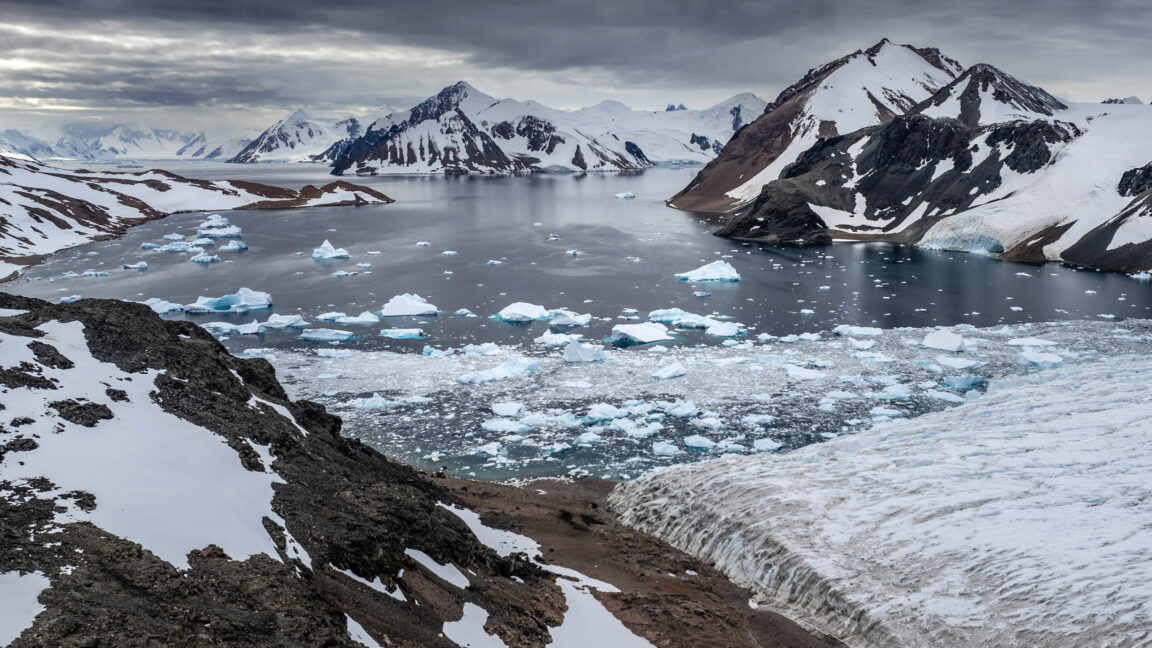Science
Antarctica Faces Greenland-like Meltdown as Ice Loss Accelerates

Recent research reveals that Antarctica is experiencing significant ice loss, resembling the rapid melting seen in Greenland. This alarming trend is attributed to human-induced climate change, which is causing both polar regions to become increasingly vulnerable. Ice caps, glaciers, and floating ice shelves in Antarctica are now showing signs of accelerated melting, raising concerns about rising sea levels and shifting precipitation patterns.
Satellite data and field observations indicate that surface melting of ice fields, faster-moving glaciers, and a reduction in sea ice are becoming commonplace. According to Ruth Mottram, an ice researcher with the Danish Meteorological Institute and lead author of a recent paper in Nature Geoscience, the notion that Antarctica’s ice sheets would remain stable has been proven incorrect. “We thought it was just going to take ages for any kind of climate impacts to be seen in Antarctica. And that’s really not true,” she stated.
The Antarctic ice sheet, which spans approximately 5.4 million square miles and contains over 61 percent of Earth’s fresh water, has the potential to raise global sea levels by about 190 feet if it were to melt entirely. Notably, the western portion of the ice sheet is particularly susceptible, with enough ice to contribute more than 10 feet to sea level rise.
One of the earliest indicators of change was the collapse of the Larsen B ice shelf in 2002, which shocked the scientific community with its rapid disintegration. Helen Amanda Fricker, a geophysics professor at the Scripps Institute of Oceanography, described the event as “staggering,” noting that the ice shelf crumbled within a matter of weeks, allowing major outlet glaciers to flow more quickly into the ocean.
Fricker emphasized that scientists once thought changes in Antarctica would occur over millennia; however, the recent collapse of ice shelves demonstrates that extreme warming can lead to rapid alterations. Current research focuses on the edges of Antarctica, where floating sea ice and narrow outlet glaciers hinder the flow of the ice cap towards the sea. “We are relying on those dams to hold back all of that ice, but the dams are weakening all around Antarctica,” she explained.
Since the 1990s, the volume of ice entering the ocean has increased fourfold. Fricker cautioned that we may soon see a significant rise in ice loss. “At some point, there’s no stopping it anymore,” she remarked.
The Antarctic Ice Sheet can be divided into three main sectors: the East Antarctic Ice Sheet, which is the largest and thickest; the West Antarctic Ice Sheet; and the Antarctic Peninsula, noted for its vulnerability to climate change. A heatwave in 2022 that reached the coldest parts of the East Antarctic Ice Sheet has raised further concerns about the continent’s connection to global climate systems.
Mottram highlighted that the extraordinary heatwave was driven by an atmospheric river, a concentrated stream of moisture-laden air, which is expected to increase in both frequency and intensity. This change indicates that Antarctica is not as isolated from the global climate system as previously believed.
Research shows that the circumpolar ocean current surrounding Antarctica has been effective in preventing the Southern Ocean from warming as rapidly as other regions. Nonetheless, recent climate models suggest that this protective barrier is weakening, allowing warmer waters to reach the bases of the ice shelves.
Eric Rignot, a professor of Earth system science at the University of California, Irvine, emphasized the importance of understanding how ocean and ice interactions affect glacial stability. He noted that recent studies on Antarctica’s floating ice shelves have become increasingly relevant in predicting future changes, akin to those observed in Greenland.
While there are similarities between the two regions, Rignot pointed out that Greenland is warming at a rate two to three times the global average, which has altered weather patterns in the Northern Hemisphere. In contrast, Antarctica is warming at a slightly lower rate than average.
Mottram’s research aims to underscore that Antarctica’s fate is intricately linked to global climate dynamics. “It’s not just this place far away that nobody goes to and nobody understands,” she said. She hopes that increased awareness of Antarctica’s importance will drive urgent action to reduce greenhouse gas emissions. “The only way we’re going to get out of this problem is bringing our greenhouse gases down as much as possible, as soon as possible.”
-

 Science3 months ago
Science3 months agoToyoake City Proposes Daily Two-Hour Smartphone Use Limit
-

 Top Stories3 months ago
Top Stories3 months agoPedestrian Fatally Injured in Esquimalt Collision on August 14
-

 Health3 months ago
Health3 months agoB.C. Review Reveals Urgent Need for Rare-Disease Drug Reforms
-

 Technology3 months ago
Technology3 months agoDark Adventure Game “Bye Sweet Carole” Set for October Release
-

 World3 months ago
World3 months agoJimmy Lai’s Defense Challenges Charges Under National Security Law
-

 Lifestyle3 months ago
Lifestyle3 months agoVictoria’s Pop-Up Shop Shines Light on B.C.’s Wolf Cull
-

 Technology3 months ago
Technology3 months agoKonami Revives Iconic Metal Gear Solid Delta Ahead of Release
-

 Technology3 months ago
Technology3 months agoApple Expands Self-Service Repair Program to Canada
-

 Technology3 months ago
Technology3 months agoSnapmaker U1 Color 3D Printer Redefines Speed and Sustainability
-

 Technology3 months ago
Technology3 months agoAION Folding Knife: Redefining EDC Design with Premium Materials
-

 Business3 months ago
Business3 months agoGordon Murray Automotive Unveils S1 LM and Le Mans GTR at Monterey
-

 Technology3 months ago
Technology3 months agoSolve Today’s Wordle Challenge: Hints and Answer for August 19









